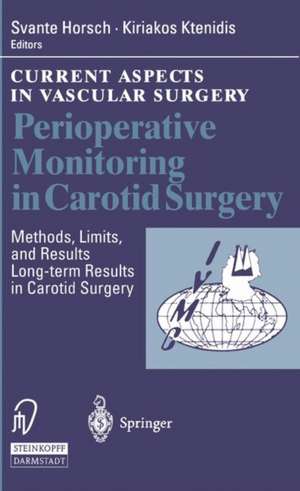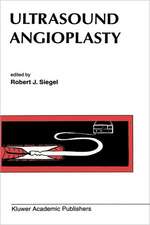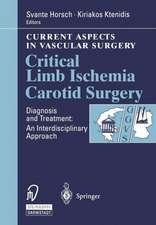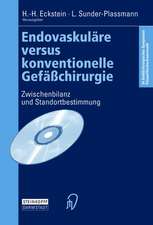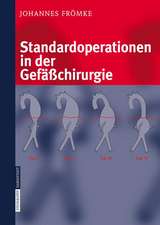Perioperative Monitoring in Carotid Surgery: Methods, Limits, and Results Long-term Results in Carotid Surgery
Editat de S. Horsch, K. Ktenidisen Limba Engleză Paperback – noi 2012
Preț: 364.33 lei
Preț vechi: 383.50 lei
-5% Nou
Puncte Express: 546
Preț estimativ în valută:
69.73€ • 75.27$ • 58.47£
69.73€ • 75.27$ • 58.47£
Carte tipărită la comandă
Livrare economică 19 aprilie-03 mai
Preluare comenzi: 021 569.72.76
Specificații
ISBN-13: 9783642959929
ISBN-10: 364295992X
Pagini: 216
Ilustrații: IX, 202 p. 94 illus.
Dimensiuni: 155 x 235 x 11 mm
Greutate: 0.31 kg
Ediția:Softcover reprint of the original 1st ed. 1998
Editura: Steinkopff
Colecția Steinkopff
Locul publicării:Heidelberg, Germany
ISBN-10: 364295992X
Pagini: 216
Ilustrații: IX, 202 p. 94 illus.
Dimensiuni: 155 x 235 x 11 mm
Greutate: 0.31 kg
Ediția:Softcover reprint of the original 1st ed. 1998
Editura: Steinkopff
Colecția Steinkopff
Locul publicării:Heidelberg, Germany
Public țintă
Professional/practitionerCuprins
I Perioperative protection.- Perioperative protection during carotid surgery on the part of the vascular surgeon.- Perioperative protective procedures in carotid endarterectomy on the part of the anaesthesiologist.- Perioperative monitoring of cerebral tissue oxygenation.- II Cerebral monitoring methods.- Electroencephalography: recording technique, pathophysiological comments, intraoperative monitoring.- Monitoring of somatosensory evoked potentials in carotid artery surgery.- Internal carotid artery back pressure to determine shunt requirement.- Measurement of regional cerebral oxygen saturation.- Postoperative evaluation of blood viscoelasticity response during carotid endarterectomy — considerable consequences for intraoperative management?.- Scintigraphic methods (PET, SPECT) to assess disturbances of the cerebral function before and after carotid endarterectomy (CEA).- III Intraoperative control methods.- Regional anesthesia in carotid surgery: technique and results.- Perioperative results of carotid endarterectomy with cervical epidural anesthesia.- Local anaesthesia and intraoperative quality control in carotid surgery.- Intraoperative angiography in carotid surgery.- IV Intraoperative ICBP, EEG, and SEP monitoring.- Intraoperative electroencephalography (EEG) monitoring and clinical outcome in carotid surgery.- ICBP in comparison to the intraoperative EEG monitoring.- Internal carotid back pressure versus somatosensory evoked potentials to determine shunt requirement.- Intraoperative monitoring during carotid endarterectomy: SEP versus EEG monitoring.- V Intraoperative Transcranial Doppler sonography and oxymetry.- Transcranial Doppler sonography and internal carotid back pressure during carotid surgery: value, limits and results in comparison tosomatosensory evoked potentials.- Use of EEG and TCD for assessment of brain function during operations on carotid artery.- Intraoperative monitoring in carotid surgery: transcranial Doppler versus somatosensory evoked potential method.- Transcranial cerebral oxymetry versus jugular venous oxygen saturation.- Transcranial cerebral oxymetry (TCO): a valid monitoring method during carotid surgery?.- VI Short- and long-term results after carotid surgery.- Polytetrafluoroethylene (PTFE) interposition graft in carotid surgery: indications and late results.- Exclusive PTFE patch angioplasty after conventional carotid endarterectomy: short- and long-term results.- Dacron versus Polyurethane (PUR) patch angioplasty in carotid surgery.- Eversion versus conventional carotid endarterectomy.- VII Short- and long-term results after carotid surgery.- Lesions of the aortic arch branches: long-term results after surgical procedures.- Operative results after reconstruction of extracranial carotid artery aneurysms (ECAA).- Carotid surgery before vertebral artery reconstruction: long-term results (1998–1994).- Ex vivo quantification of carotid stenoses: evaluation of eversion endarterectomy specimen.- Consensus conference on perioperative monitoring.
